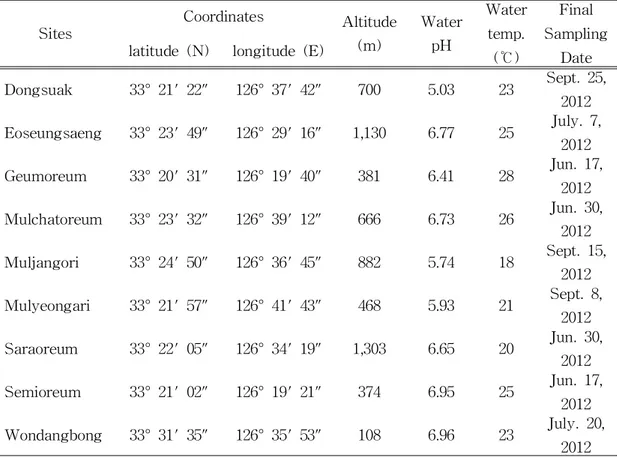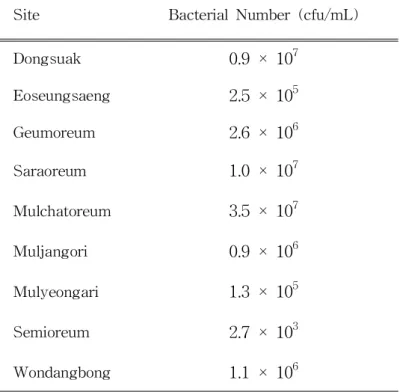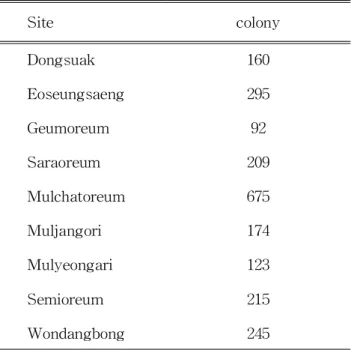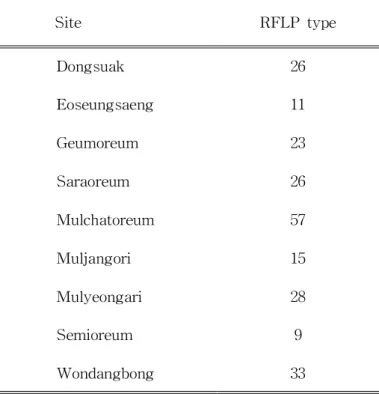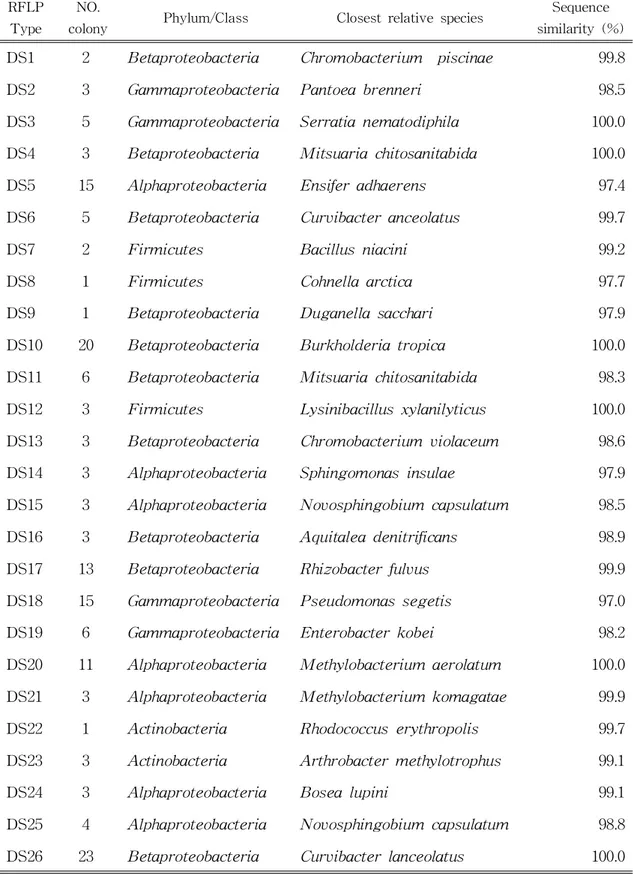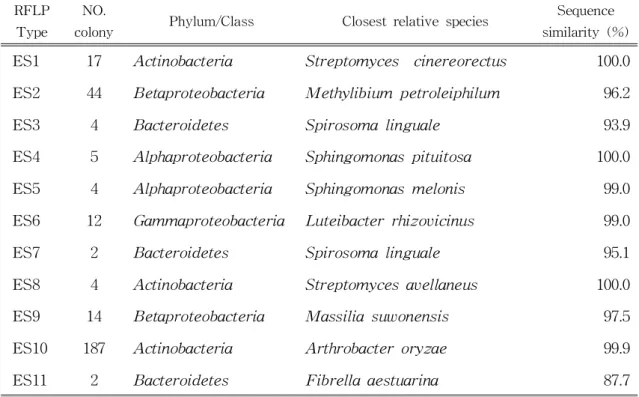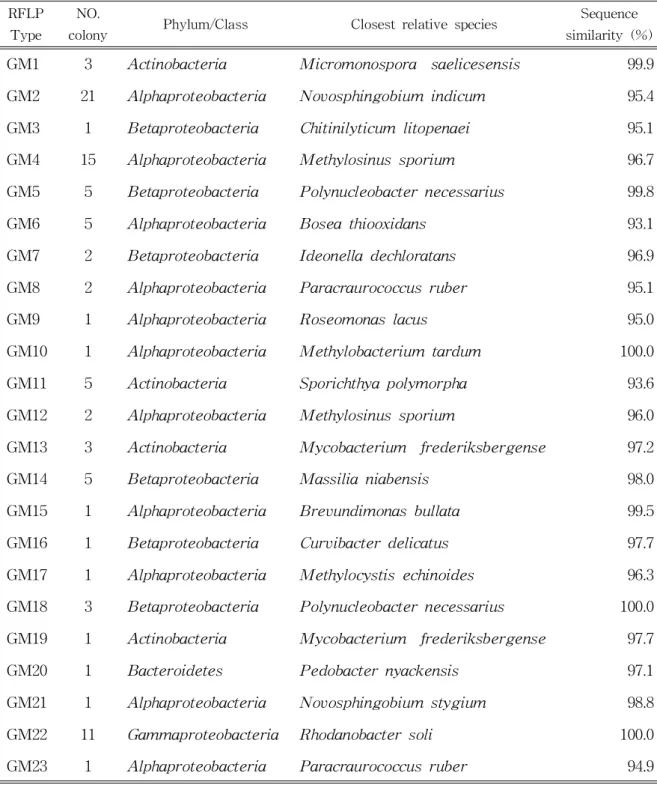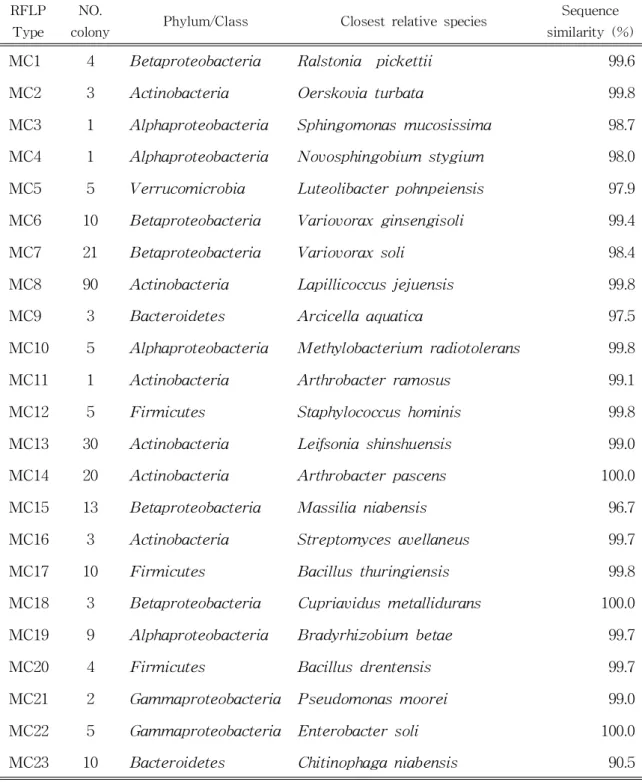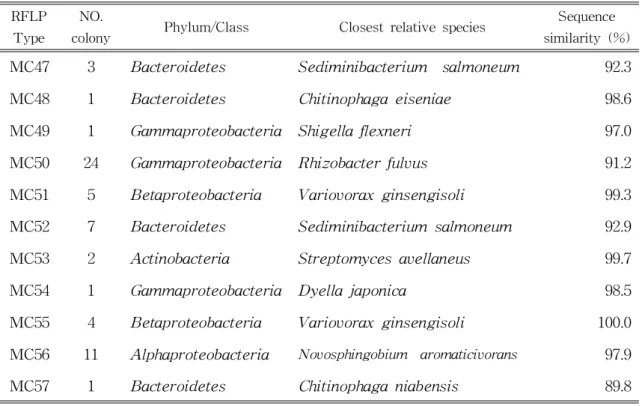저작자표시 2.0 대한민국 이용자는 아래의 조건을 따르는 경우에 한하여 자유롭게 l 이 저작물을 복제, 배포, 전송, 전시, 공연 및 방송할 수 있습니다. l 이차적 저작물을 작성할 수 있습니다. l 이 저작물을 영리 목적으로 이용할 수 있습니다. 다음과 같은 조건을 따라야 합니다: l 귀하는, 이 저작물의 재이용이나 배포의 경우, 이 저작물에 적용된 이용허락조건 을 명확하게 나타내어야 합니다. l 저작권자로부터 별도의 허가를 받으면 이러한 조건들은 적용되지 않습니다. 저작권법에 따른 이용자의 권리는 위의 내용에 의하여 영향을 받지 않습니다. 이것은 이용허락규약(Legal Code)을 이해하기 쉽게 요약한 것입니다. Disclaimer 저작자표시. 귀하는 원저작자를 표시하여야 합니다.
석 사 학 위 논 문
제주도 화구호 습지의 세균군집 분석
제주대학교 대학원
생물학과
변 후 돈
2013년 2월
목 차
목 차 ···ⅰ ListofTables···ⅲ ListofFigures···ⅴ Abstract···ⅶ Ⅰ.서 론 ···1 Ⅱ.재료 및 방법 ···4 2.1.조사지 및 시료의 채취 ···4 2.2.세균수 측정,세균 분리 ···7 2.3.배양 된 세균의 군집 분석 ···72.3.1.GenomicDNA 추출 ···7
2.3.2.16S rRNA 유전자의 ARDRA···7 2.3.3.염기서열 및 계통학적 분석 ···8 Ⅲ.결 과 및 고찰 ···10 3.1.세균 수 ···10 3.1.1.시료의 세균 수 ···10 3.2.세균의 분리 및 배양 ···11
3.2.1.세균의 분리 ···11 3.3.세균의 군집 분석 ···13 3.3.1.16S rRNA 유전자의 ARDRA···13 3.3.2.염기서열 및 계통학적 분석 ···15 Ⅳ.요 약 ···50 Ⅴ.참고 문헌 ···52 Ⅵ.감사의 글 ···63
Li
stoft
abl
es
Table1.Geographicinformation ofsampling sitesandphysicaldataofwater
samples···6 Table2.BacterialNumberofsamplesfrom investigationsites···10 Table3.Numberofcolonyisolatedfrom differentsamplingsites···12
Table4.NumberofRFLP typesofsamplescollectedateachsamplingsite14
Table5.ThePhylogeneticrelativesofrepresentativestrainfrom eachRFLP
typestrainsfrom Dongsuak sampleby 16S rRNA genesequence
similarity···16
Table6.ThePhylogeneticrelativesofrepresentativestrainfrom eachRFLP
typestrainsfrom Eoseungsaeng sampleby 16S rRNA genesequence
similarity···19
Table7.ThePhylogeneticrelativesofrepresentativestrainfrom eachRFLP
typestrainsfrom Geumoreum sampleby 16S rRNA genesequence
similarity···22
Table8.ThePhylogeneticrelativesofrepresentativestrainfrom eachRFLP
typestrainsfrom Saraoreum sampleby 16S rRNA genesequence
Table9.ThePhylogeneticrelativesofrepresentativestrainfrom eachRFLP
typestrainsfrom Mulchatoreum sampleby 16S rRNA genesequence
similarity···29
Table10.ThePhylogeneticrelativesofrepresentativestrainfrom eachRFLP
typestrainsfrom Muljangorisampleby 16S rRNA genesequence
similarity···34
Table11.ThePhylogeneticrelativesofrepresentativestrainfrom eachRFLP
typestrainsfrom Mulyeongarisampleby 16S rRNA genesequence
similarity···37
Table12.ThePhylogeneticrelativesofrepresentativestrainfrom eachRFLP
typestrainsfrom Semioreum sampleby 16S rRNA genesequence
similarity···41
Table13.ThePhylogeneticrelativesofrepresentativestrainfrom eachRFLP
typestrainsfrom Wondangbong sampleby 16S rRNA genesequence
Li
stoff
i
gur
es
Fig.1.ThemapofsamplingsitesontheJejuIsland.···4 Fig.2.Photographofsamplingsites.···5
Fig.3.Neighbor-joiningphylogenetictreebasedon16S rRNA genesequences
ofculturedbacteriafrom sampleofDongsuak.···17
Fig.4.Neighbor-joiningphylogenetictreebasedon16S rRNA genesequences
ofculturedbacteriafrom sampleofEoseungsaeng.···20
Fig.5.Neighbor-joiningphylogenetictreebasedon16S rRNA genesequences
ofculturedbacteriafrom sampleofGeumoreum.···23
Fig.6.Neighbor-joiningphylogenetictreebasedon16S rRNA genesequences
ofculturedbacteriafrom sampleofSaraoreum.···26
Fig.7.Neighbor-joiningphylogenetictreebasedon16S rRNA genesequences
ofculturedbacteriafrom sampleofMulchatoreum.···32
Fig.8.Neighbor-joiningphylogenetictreebasedon16S rRNA genesequences
ofculturedbacteriafrom sampleofMuljangori.···35
Fig.9.Neighbor-joiningphylogenetictreebasedon16S rRNA genesequences
Fig.10.Neighbor-joiningphylogenetictreebasedon16S rRNA genesequences ofculturedbacteriafrom sampleofSemioreum.···42 Fig.11.Neighbor-joiningphylogenetictreebasedon16S rRNA genesequences
ofculturedbacteriafrom sampleofWondangbong.···46 Fig.12.Comparisonofbacterialcommunitiesofstudysitesinthephylum/class level.···47
Abst
r
act
In thisstudy,bacterialsampleswerecollected from 9volcanicwetlandson the Jeju Island and culturable bacteria were isolated. Subsequently, we analyzedthebacterialcommunitiesthrough RFLP (restriction fragmentlength
polymorphism) typing by HaeⅢ digestion and sequence analysis of PCR
amplified16S rRNA genesofisolatedbacteria.
From Dongsuak wetland sample,160 colonies werepicked and divided into
26 RFLP patterns.The bacterialspecies were distributed in three phyla, Actinobacteria,Firmicutes and Proteobacteria and among these phyla,most bacterialspeciesweredistributedintheclassβ-Proteobacteriaofthephylum Proteobacteria. In Eoseungsaeng sample, 295 colonies were picked and dividedinto11RFLP patterns.Threephyla,Actinobacteria,Bacteroidetesand Proteobacteria, were confirmed. The bacterial species belonging to the
phylum Actinobacteriawereapproximately 70% oftotalnumbersofspecies.
Arthrobacter oryzae was predominant.In Geumoreum sample,92 colonies
werepicked and divided into23RFLP patterns.Threephyla,Actinobacteria,
Bacteroidetesand Proteobacteria,wereconfirmed.The numbers ofbacterial specieswerefound,indescendingorder,intheclassesofα-Proteobacteria,β -Proteobacteria,Actinobacteria,γ-Proteobacteria.The numbers ofbacterial species belonging to the class Sphingobacteria ofthe phylum Bacteroidetes
were counted for approximately 1 %. In Saraoreum, 209 colonies were
separated and divided into 26 RFLP patterns.They were classified into 4
phyla and 3classes.Thegenera Variovorax,Acidovorax,and Paralcaligenes
weredominantinβ-Proteobacteriaclass.InMulchatoreum,675colonieswere
pickedanddividedinto57RFLP patterns.Thebacterialspeciesfoundinthis
sample belonged to 8 classes in 5 phyla,and showed the highestdiversity
mostabundantbacterialspecies in the phylum and class levelrespectively.
The numbers ofbacterial species were shown,in descending order,in the
classes of β-Proteobacteria, Actinobacteria, α-Proteobacteria and γ -Proteobacteria, the class Bacilli of the phylum Firmicutes, the class Cytophagia ofthe phylum Bacteroidetes,the class Sphingobacteria and the classVerrucomicrobiaeofthephylum Verrucomicrobia.InMuljangorisample,
174colonieswerepickedanddividedinto15RFLP patterns.Thenumbersof
bacterial species belonging to the phylum Proteobacteria accupied
approximately99%,and thephylum Actinobacteriaaccupiedtheremaining1
%.Inthephylum Proteobacteria,onlytwoclassesofα-Proteobacteriaandβ
-Proteobacteria were shown. In Mulyeongari sample, 123 colonies were picked and divided into 28 RFLP patterns.In the classβ-Proteobacteria,
much bacterial species belonging to the genera Pelomonas and
Herbaspirillum were isolated. The genus Rhizobium in the class α -Proteobacteria and genus Pantoea in the class γ-Proteobacteria were commonly found.In addition,bacteria belonging to the class Flavobacteria
andSphingobacteriainthephylum Bacteroideteswereisolated.InSemioreum
sample,215 colonies were picked and divided into 9 RFLP patterns.The
numbers of bacterial species belonging to the class α-Proteobacteria, Actinobacteriaand Flavobacteriawereisolated.thegeneraNovosphingobium, Beijerinckia and Shinella were shown in the classα-Proteobacteria.In the class Actinobacteria, the bacteria belonging to genera Micrococcus, Micromonospora,Sporichthya and Arthrobacterwere shown.Flavobacterium was isolated in the class Flavobacteria of the phylum Bacteroidetes.In
Wondangbong sample,245 colonies were picked and divided into 33 RFLP
patterns.Thebacteriawereisolatedin 6classesof4phyla.Thenumbersof
bacterial species belonging to the phyla Proteobacteria, Actinobacteria, Bacteroidetes and Firmicutes were isolated, and were most frequently
Actinobacteria.Atthe class level,the bacteria were frequently separated in orderActinobacteria,α-Proteobacteria,γ-Proteobacteriaandβ-Proteobacteria.
Ⅰ.서 론
습지는 영구적으로나 계절적으로 습한 상태를 유지하면서 육상생태계와 수생태계의 중간지대의 특성을 지니고 있는 독특한 환경의 전이지대이며,이에 적응해온 특별한 생물상이 서식하고 있는 동적 생태계로 습지에 의지하는 생물상 역시 생산성과 다양성이 높은 것으로 알려져 종 다양성이 높은 생태계로 여겨지고 있다 (
Mitschetal.,1993;Dobsonetal.,2008).
화구는 화산활동으로 생긴 원형의 지형으로,산정화구,측화구,칼데라,마르, 화산탄의 충돌구,용암류 표면의 함몰요지 등을 포함한다.분출구 가운데 직경이 2 Km를 넘는 경우는 칼데라라고 하며,2 Km 이하로서 화산 화구의 상대적인 위치에 따라 산정화구,중앙화구,측화구 등으로 구분한다 (Kim,2011).화구호 습지는 분화구가 오랜 시간에 걸쳐 지속적인 퇴적으로 형성되며 제주도의 화구호 습지는 거의 한라산 고지대에 분포하고 있기 때문에 외부와 차단되어 독특한 생태계를 형성하고 호수습지를 형성해 수생식물군락이 잘 보존되어 있어 생태 연구의 가치가 높다.습지는 생태계 내에서 물질순환이 일어나는 중요한 장소로서 지구상의 무생물 요인과 생물적인 요인을 연결시켜주는 촉매 역할을 한다 (Hoppe,1983;Jakobetal.,1998). 일부 세균은 독립영양생물로서 이산화탄소를 고정하여 새로운 유기물질을 합성 하는 반면 또 다른 세균들은 유기영양 생물로서 물질의 생물학적 분해에 참여하여 유기물 및 무기물을 순환 시키는 역할을 하고 있고 (Weisse,1992),생태계의 안정적인 유지를 위한 필수적인 생물이며 다른 생물종과는 비교도 안 되는 수적인 방대함과 종다양성으로 인해 다양한 환경에서 발견되고 있다.이러한 세균의 종다양성은 세균이 수행하는 역할 및 특성의 다양화를 야기하여 자연 환경에서 뿐만 아니라 산업 등에서 유용한 자원으로 세균의 잠재적 역할은 증대되고 있다. 세균은 이렇게 자연계 내에서 중요한 역할을 하고 있고,세균은 서식환경의 조건
과 기능을 이해하는데 도움을 주기 때문에 환경에서 세균군집의 역할과 기능을 알아보기 위해서는 세균군집의 다양한 특성을 파악하고,다른 환경 조건에서 각
각의 세균을 분석하여 상호 비교 또한 필요하다 (Amannetal.,1995;Holbenet
al.,1995;Guschinetal.,1997;Torsviketal.,2002).세균군집을 분석하는데 있
어서 배양법으로는 상당한 제한성이 있다.자연계에 존재하는 전체 미생물에서 실제적으로 배양이 가능한 경우는 환경에 따라 1% 미만으로 99% 이상이 배양 이 될 수 없다고 보고되고 있다 (Amannetal.,1995).최근에 세균군집 구조 분 석을 위해 16S rRNA 유전자를 분자 지표로 사용함으로써 다양한 환경에서 세균 군집을 분석하는 시도가 널리 사용되고 있는데 16S rRNA 유전자의 특정 부분은 진화속도가 매우 느려 많은 생물체가 공통적으로 갖는 보존된 염기서열과 이차 구조를 나타내어 다양한 분류군의 상호 비교를 가능하게 한다 (Amann etal., 1995).PCR 과정에서 나타나는 chimericsequence의 출현으로 인한 자연에 존재 하지 않는 세균의 보고 등 몇몇 문제점에도 불구하고 배양의 어려움에 따른 세 균의 군집분석의 제한성을 상당히 해결할 수 있어 많은 연구자들이 사용하고 있 다 (Hugenholtz etal.,2003).PCR-restriction fragmentlength polymorphism
(PCR-RFLP)방법인 amplified ribosomalDNA restriction analysis(ARDRA)
는 일부 세균군집의 종 특이적 동정 방법으로 사용될 뿐 만 아니라,다양한 세균
이 서식하고 있는 생태계의 군집 분석에도 사용되고 있는 방법이다 (Urakawaet
al.,1999;Venturaetal.,2001;Leeetal.,2004).
세계자연문화유산 및 경관 보전지역인 제주도에 산재하는 오름 368개 중 산정 화구에 존재하는 금오름,동수악,물영아리,물장오리,물찻오름,사라오름,새미 오름,어승생,원당봉 9곳의 화구습지는 고도와 식생에 따라 다양한 생태계를 갖 고 있어 (Kim etal.,2001),식물상과 곤충에 관한 연구가 활발하게 이루어지고 있는 반면 습지 생태계에 가장 기본이 되는 세균학적인 군집 및 특성분석은 이 루어지지 않아 세균 분포에 대한 정보가 거의 없다 (Choietal.,2011;Jeong,
2011;Shinetal.,2011;Choi,2012).
본 연구는 화구습지에 존재하는 배양 가능한 세균을 분리하고 16S rRNA 유전
자 염기서열 분석을 통하여 다른 세균과의 연관성을 밝히고, Ribosomal
database를 이용하여 계통 분류학적 관점에서 비교가 가능하도록 정리하여 제주 도 화구습지에 존재하는 세균 군집을 규명하고자 실시하였다.
Fig.1. Themapofsampling siteson theJeju Island.
Ⅱ.재료 및 방법
2.
1.조사지 및 시료의 채취
본 연구의 조사지는 동수악,어승생,금오름,사라오름,물찻오름,물장오리,물 영아리,새미오름,그리고 원당봉 등 9곳의 화구호 습지로서 제주도의 여러 곳에 분포하고 있으며 (Fig.1.,Fig.2.),2012년 6월에서 9월 사이에 멸균된 용기에 물 과 바닥의 흙을 같이 채취하여 채취장소의 좌표,해발고도와 수온을 측정하고 실 험실로 옮긴 후 pH를 측정하였다 (Table1).DS : Dongsuak ES : Eoseungsaeng GM : Geumoreum SR : Saraoreum MC : Mulchatoreum MJ : Muljangori MY : Mulyeongari SM : Semioreum WD : Wondangbong
Dongsuak Eoseungsaeng Geumoreum
Saraoreum Muljangori Mulyeongari
Mulchatoreum Semioreum Wondangbong Fig.2.Photographsofsampling sites.
Table 1.Geographic information ofsampling sites and physicaldata ofwater samples
Sites
Coordinates Altitude (m) Water pH Water temp. (℃) Final Sampling Date latitude(N) longitude(E)
Dongsuak 33°21'22" 126°37'42" 700 5.03 23 Sept.25, 2012 Eoseungsaeng 33°23'49" 126°29'16" 1,130 6.77 25 July.7,
2012 Geumoreum 33°20'31" 126°19'40" 381 6.41 28 Jun.17,
2012 Mulchatoreum 33°23'32" 126°39'12" 666 6.73 26 Jun.30,
2012 Muljangori 33°24'50" 126°36'45" 882 5.74 18 Sept.15,
2012 Mulyeongari 33°21'57" 126°41'43" 468 5.93 21 Sept.8,
2012 Saraoreum 33°22'05" 126°34'19" 1,303 6.65 20 Jun.30,
2012 Semioreum 33°21'02" 126°19'21" 374 6.95 25 Jun.17,
2012 Wondangbong 33°31'35" 126°35'53" 108 6.96 23 July.20,
2.
2.세균수 측정,세균 분리
채취한 시료 1mL 를 voltex 한 후 멸균한 0.85% NaCl용액 9mL 에 현탁하
였고,같은 용액에 연속적으로 10-1 ∼ 10-5 배가 되게 희석 후 R2A Agar
(Difco,USA)배지와 1/5배 NutrientAgar(Difco,USA)배지에 100μL씩 도말하
여 30℃에서 5일간 배양한 후 cfu/mL 로서 시료의 세균수를 측정하였으며,세 균의 분리는 육안으로 집락 형태와 크기에 유의하여 선별하고,선별한 균주를 동 일배지와 온도에서 단일 집락으로 판단될 때 까지 계대배양하며 순수분리 하였 고,순수분리 된 균주들은 액체 배양하여 배양액을 glycerol(20%,w/v)용액에 현탁하여 -70℃에서 냉동 보관하였다.
2.
3.배양된 세균의 군집 분석
2.3.1.GenomicDNA 추출순수 분리 된 미생물 균체 1 loop를 5 % Chelex (MolecularBiology Grade
Resin,200-400mesh,Sodium Form,BIO-RAD)100μL에 풀어서 끓는 물에서
5분간 반응시키고 얼음에서 식히는 방법으로 DNA를 추출하여 spin down 후
-20℃에서 냉동 보관하였다.
2.3.2.16S rRNA 유전자의 ARDRA(amplifiedrDNA restriction analysis)
16S rRNA 유전자 증폭은 universalprimer27F (5'-AGA GTT TGA TCC
TGG CTC AG-3')와 1522R (5'-AAG GAG GTG ATC CAG CCGCA-3')을 사
용하여 DNA 1.2 μL,SP-Taq Polymerase 0.15 μL,10X G-Taq Buffer3 μL,
2.5 mM dNTPsmixture0.6 μL,forward와 reverse primer각각 1.2 μL,멸균
된 증류수 22.75μL로 총 양 30μL 의 조건으로 PCR을 실행하였다.PCR 반응
95℃에서 5분간 initialdenaturation 한 후,95℃에서 1분간 denature,55℃에
서 1분간 annealing,72℃에서 1분간 elongation 반응을 총 30 회 반복하고 72
℃에서 10분간 finalextension 을 수행하였다.PCR 산물 2μL를 1% Agarose
gel에서 100V,30분간,0.5X TAE Buffer로 전기영동 하여 1 Kb Labo DNA
Ladder을 이용하여 크기를 확인하였다.
증폭 된 16S rRNA의 RFLP (Restriction FragmentLength Polymorphism)분
석을 위해 제한효소 HaeⅢ (GG↓CC;TaKaRa,Japan)를 사용하였으며,PCR 산
물 8μL,HaeⅢ 0.5μL,10×Buffer1μL,멸균 된 증류수 0.5μL를 섞은 10μL
를 37℃에서 2시간 반응시켰다.반응액 10μL 는 0.5×TAE Buffer로 2.5%
Agarosegel에서 50V로 2시간 30분 동안 전기영동을 하였고,100bpDNA
Ladder (Bioneer)를 이용하여 제한효소에 의해 잘린 밴드의 크기를 확인하고
RFLP pattern을 비교하였다.
2.3.3.염기서열 및 계통학적 분석
ARDRA 분석을 통해 동일한 RFLP 절단양상을 나타내는 집락을 모아 유형별로 구분하고 각 유형 중 대표균주를 선별하여 염기서열 분석을 위해 TNT-P200
PCR PurificationKit(TNT research,Korea)를 이용하여 정제를 하였다.
정제 된 균주의 rRNA 유전자 염기서열 분석은 ABIBigDyeTerminatorCycle
Sequencing Kitsv3.1(AppliedBiosystems)과,27F primer를 사용하여 capillary
방식의 ABI3730XL DNA Analyzer(AppliedBiosystems)를 이용하였다.분석된
염기서열은 Basic LocalAlignmentSearch Tool(BLAST)search program을
이용하여 NationalCenterforBiotechnology Information (NCBI)의 Genbank
database와 EzTaxon server(Chun etal.,2007)에서 유사한 염기서열을 비교하
고,가장 근연속이나 종으로 나타나는 서열을 확인하였다.본 연구에 의해서 결
정 된 염기서열과 database에서 검색 된 근연 세균의 염기서열은 Mega 5.05
software에 포함된 ClustalW 프로그램을 이용하여 multiplealignment로 정렬
하였다 (Tamura etal.,2011).진화적 거리는 Jukes & Cantordistance model
(Saitou& Nei,1987)을 이용하여 계통수를 작성하였다.Treetopology의 신뢰성
을 평가하기 위하여 1000회의 replication을 적용한 bootstrap 분석을 하였다
Ⅲ.결과 및 고찰
3.
1.세균 수
3.1.1.시료의 세균 수 각 조사지의 시료를 평판배지에 적정한 희석비의 현탁액을 도말한 후 배양된 집락의 수 (cfu/mL)는 Table2.에 나타나 있다.이 결과는 3회 반복 후 평균을 내었다.Table2.Bacterialnumberofsamplesfrom investigation sites
Site BacterialNumber(cfu/mL) Dongsuak 0.9× 107
Eoseungsaeng 2.5× 105
Geumoreum 2.6× 106 Saraoreum 1.0× 107 Mulchatoreum 3.5× 107 Muljangori 0.9× 106 Mulyeongari 1.3× 105 Semioreum 2.7× 103 Wondangbong 1.1× 106
3.
2.세균의 분리 및 배양
3.2.1.세균의 분리 Petridish 상에 배양 된 세균은 집락의 모양,색깔,크기,생장속도를 비교하여 집락의 수를 계수하였다.비가 온 후에만 물이 고이는 지역인 동수악에서는 상이 한 160개의 집락이 분리되었고,어승생에서는 295개 집락이 분리되었으며,금오 름에서는 92개 집락,사라오름에서는 209개 집락이 분리되었다.항상 물이 차있 는 지역인 물찻오름에서는 675개의 집락이 분리되었으며,물장오리에서 174개의 집락,물영아리에서 123개의 집락이 분리되었다.기존 화구호에 인공으로 재조성 된 습지인 새미오름과 원당봉에서는 각각 215개 집락,245개 집락이 분리되었다 (Table3).Table3.Numberofcolony isolated from differentsampling sites
Site colony Dongsuak 160 Eoseungsaeng 295 Geumoreum 92 Saraoreum 209 Mulchatoreum 675 Muljangori 174 Mulyeongari 123 Semioreum 215 Wondangbong 245
3.
3.세균의 군집 분석
3.3.1.16S rDNA 유전자의 ARDRA(amplifiedrDNA restriction analysis)
각 조사지의 시료에서 분리된 집락의 RFLP 절단양상에 따라 유형을 나누었고, 분류한 유형 내에서 대표를 선정하여 염기서열 및 계통학적 분석에 사용하였다. 제한효소 HaeⅢ에 의해 절단된 16S rRNA 유전자를 동일한 RFLP 절단양상을 기준으로 분류한 결과 동수악은 26개의 유형,어승생 11개,금오름 23개,사라오 름 26개,물찻오름 57개,물장오리 15개,물영아리 28개,새미오름 9개,원당봉 33 개 유형으로 분류되었으며 (Table4),물찻오름의 시료에서 가장 많은 유형 (57 개)이 나타났고 새미오름은 가장 적은 9개의 유형으로 분석되어 6배 이상의 차이 를 보였다.이는 식생이 풍부한 물찻오름과 인공이 가미된 습지로서 식생이 거의 없어 유기물을 이용하는 세균이 서식하기 어려운 환경인 새미오름 습지의 차이 로 해석된다.원당봉의 경우도 새미오름과 같이 인공이 가미된 습지로서 식생이 거의 없는 지역이지만 화구호 습지 주변으로 사찰과 체육공원 시설이 있어 사람 들의 출입이 자유로워 외부의 세균이 지속적으로 유입이 되어 비교적 다양한 유 형이 나타난 것으로 보인다.
Table4.NumberofRFLP typesofsamplescollectedateach sampling site
Site RFLP type Dongsuak 26 Eoseungsaeng 11 Geumoreum 23 Saraoreum 26 Mulchatoreum 57 Muljangori 15 Mulyeongari 28 Semioreum 9 Wondangbong 33
3.3.2.염기서열 및 계통학적 분석 16S rRNA 유전자는 돌연변이가 잘 일어나지 않아 그 염기서열을 비교함으로 써 세균을 분류하는데 널리 쓰인다.많은 연구자들에 의하여 세균들의 rRNA 염 기 서열에 대한 자료가 축적되어 가고 있고,16S rRNA 염기서열 분석법의 자동 화로 인해 더 쉽고 정확하게 세균을 분류 할 수 있게 되었다. 각 조사지의 시료에서 분리 된 균주 중 분석 된 16S rRNA 염기서열은 염기서
열간의 유사도를 확인하기 위해 BLAST search program을 이용하여 NCBI의
Genbank와 EzTaxon server에서 유사한 염기서열을 비교하고,가장 근연 속이
나,종으로 나타나는 서열을 확인하였다.
동수악에서 분리한 160개의 집락 중 RFLP 유형이 동일한 균주들을 선발하여
염기서열을 분석한 결과 Actinobacteria,Firmicutes,Proteobacteria의 3개의 문
에서 Actinobacteria, Bacilli, α-Proteobacteria, β-Proteobacteria 와 γ -Proteobacteria의 5개의 강이 확인되었다 (Table5,Fig.3.).Proteobacteria문
이 약 93 %를 차지하여 우세하였고,Firmicutes약 4 %,Actinobacteria 약 3
%를 차지하였다.Proteobacteria문의 α-Proteobacteria,β-Proteobacteria와 γ
-Proteobacteria 3개의 강 중에서 β-Proteobacteria강이 약 53%를 차지하였 고, α-Proteobacteria 28 %, γ-Proteobacteria 약 19 %를 차지하였다. Firmicutes문에서는 Bacilli강,Actinobacteria문에서는 Actinobacteria강만이
나타났다. 가장 우세하게 나타난 β-proteobacteria 강에서는 우물물에서 발견
된 Curvibacterlanceolatus,질소고정세균으로 알려져 있는 Burkholderiatropica
가 많이 나타났다 (Linxian Ding et al.,2004;V.M.Reis et al.,2004).α
-Proteobacteria강에서 많이 나타난 Ensifer속은 토양에서 분리되는 세균으로
알려져 있다 (L.E.CASIDA,JR.,1982;Lietal.,2011)γ-Proteobacteria에서
많이 나타난 Pseudomonassegetis도 토양에서 분리된 세균 (Parketal.,2006)
으로 많이 나타난 세균들을 보면 동수악의 환경이 수계와 토양환경의 중간 단계 를 나타내고 있다고 보여 진다.실재 동수악은 솔비나무가 점차 습지 내부로 영 역을 확장하고 있어서 장마철 이외에는 물이 고이지 않고 있으며 육지화가 가속
RFLP Type
NO.
colony Phylum/Class Closestrelativespecies
Sequence similarity(%)
DS1 2 Betaproteobacteria Chromobacterium piscinae 99.8
DS2 3 Gammaproteobacteria Pantoeabrenneri 98.5
DS3 5 Gammaproteobacteria Serratianematodiphila 100.0
DS4 3 Betaproteobacteria Mitsuariachitosanitabida 100.0
DS5 15 Alphaproteobacteria Ensiferadhaerens 97.4
DS6 5 Betaproteobacteria Curvibacteranceolatus 99.7
DS7 2 Firmicutes Bacillusniacini 99.2
DS8 1 Firmicutes Cohnellaarctica 97.7
DS9 1 Betaproteobacteria Duganellasacchari 97.9
DS10 20 Betaproteobacteria Burkholderiatropica 100.0
DS11 6 Betaproteobacteria Mitsuariachitosanitabida 98.3
DS12 3 Firmicutes Lysinibacillusxylanilyticus 100.0
DS13 3 Betaproteobacteria Chromobacterium violaceum 98.6
DS14 3 Alphaproteobacteria Sphingomonasinsulae 97.9
DS15 3 Alphaproteobacteria Novosphingobium capsulatum 98.5
DS16 3 Betaproteobacteria Aquitaleadenitrificans 98.9
DS17 13 Betaproteobacteria Rhizobacterfulvus 99.9
DS18 15 Gammaproteobacteria Pseudomonassegetis 97.0
DS19 6 Gammaproteobacteria Enterobacterkobei 98.2
DS20 11 Alphaproteobacteria Methylobacterium aerolatum 100.0 DS21 3 Alphaproteobacteria Methylobacterium komagatae 99.9
DS22 1 Actinobacteria Rhodococcuserythropolis 99.7
DS23 3 Actinobacteria Arthrobactermethylotrophus 99.1
DS24 3 Alphaproteobacteria Bosealupini 99.1
DS25 4 Alphaproteobacteria Novosphingobium capsulatum 98.8
DS26 23 Betaproteobacteria Curvibacterlanceolatus 100.0
Table5.ThePhylogeneticrelativesofrepresentativestrain from each RFLP type strainsfrom Dongsuak sampleby 16S rRNA genesequencesimilarity
Fig.3.Neighbor-joining phylogenetictreebased on 16S rRNA genesequences ofcultured bacteria from sample ofDongsuak.Numbers on branch nodes are bootstrapvaluesexpressedaspercentages(1000replicates).Bar,0.02substitutions
어승생에서는 11개 RFLP유형이 나타났고 이들의 16S rRNA 유전자의 염기서
열을 분석하고 가까운 종을 검색한 바, Actinobacteria, Bacteroidetes,
proteobacteria 문을 확인하였다 (Table 6,Fig.4.).Actinobacteria 문이 약 70
%를 차지함으로써 우점하였고,proteobacteria문이 약 27%,Bacteroidetes문
이 약 3 % 가 나타났다. proteobacteria 문에서는 α-Proteobacteria,β
-Proteobacteria 와 γ-Proteobacteria 가 나타났으며,β-Proteobacteria 약 74 %,γ-Proteobacteria 약 15 %,α-Proteobacteria 약 11 % 가 나타났다. Actinobacteria 문에서는 Actinobacteria 강이, Bacteroidetes 문에서는 Cytophagia강 만이 나타났다.강 수준에서 살펴보면,Actinobacteria강이 약 70 %,β-Proteobacteria 강은 약 20 %,γ-Proteobacteria 강이 약 4 %,α -Proteobacteria 강,Cytophagia 강이 각각 약 3 %를 차지하는 것으로 나타났 다.Actinobacteria 강의 Arthrobacter 속이 아주 우세하게 나타났다.어승생의
시료에서는 Arthrobacter속의 Arthrobacteroryzae 가 가장 우점하는 것으로
나타났다.이 세균은 논 토양에서 발견 된 것으로 보고되어졌으며 (Kageyama
etal.,2008),β-Proteobacteria강의 Methylibium 속이 다음으로 많이 나타났으
며 늪지대의 물,인삼 밭 토양 등에서 분리가 되었다(Song etal.,2007;Yoonet
al.,2007).어승생의 환경이 비가 온 후에는 물이 고여 있으면서 수계 환경이,그
외의 시기에는 물을 많이 가지고 있지 않은 일반적인 토양 환경을 유지하고 있 기에 수계 환경에서 나타나는 세균과 토양 환경에서 나타나는 세균이 같이 나타 날 수 있었다고 보여 지며,이는 어승생이 수생태계와 육상생태계 중간지대임을 보여 준다고 사료된다.
Table 6.The Phylogenetic relatives ofrepresentative strain from each RFLP typestrainsfrom Eoseungsaeng sampleby 16S rRNA genesequencesimilarity
RFLP Type
NO.
colony Phylum/Class Closestrelativespecies
Sequence similarity(%)
ES1 17 Actinobacteria Streptomyces cinereorectus 100.0 ES2 44 Betaproteobacteria Methylibium petroleiphilum 96.2
ES3 4 Bacteroidetes Spirosomalinguale 93.9
ES4 5 Alphaproteobacteria Sphingomonaspituitosa 100.0
ES5 4 Alphaproteobacteria Sphingomonasmelonis 99.0
ES6 12 Gammaproteobacteria Luteibacterrhizovicinus 99.0
ES7 2 Bacteroidetes Spirosomalinguale 95.1
ES8 4 Actinobacteria Streptomycesavellaneus 100.0
ES9 14 Betaproteobacteria Massiliasuwonensis 97.5
ES10 187 Actinobacteria Arthrobacteroryzae 99.9
Fig.4.Neighbor-joining phylogenetictreebased on 16S rRNA genesequences ofcultured bacteria from sample ofEoseungsaeng.Numbers on branch nodes are bootstrap values expressed as percentages (1000 replicates). Bar, 0.02 substitutionspernucleotideposition.
금오름에서 분리 된 92개의 집락은 23개의 RFLP유형으로 나타났고 각 유형의
균주를 16S rRNA 유전자의 염기서열과 가까운 종을 검색한 결과
Actionobacteria,Bacteroidetes,Proteobacteria 3개의 문으로 나눌 수 있었다
(Table7,Fig.5.).Proteobacteria문이 가장 많이 분리되어 약 86%를 차지하
였다.그 다음으로 Actionobacteria문이 약 13%가 나타났고 Bacteroidetes문
이 약 1 %가 나타났다.가장 많이 나타난 그룹인 Proteobacteria 문은 α
-Proteobacteria, β-Proteobacteria, γ-Proteobacteria 강이 나타났고, Proteobacteria문내에서만 비교해 보았을 때 α-Proteobacteria강이 약 65%를
차지하였고 β-Proteobacteria강이 약 21%,γ-Proteobacteria강이 약 14%를
차지하는 것으로 나타났다.금오름에서 분리된 세균을 강 수준에서 살펴보면, Actionobacteria 강이 약 13 %를 차지하고 Bacteroidetes 문 (phylum)의 Sphingobacteria강이 약 1%를 차지하였고 α-Proteobacteria강은 약 55%,β -Proteobacteria 강은 약 18 %,γ-Proteobacteria 강은 약 12 % 가 나타났다.
가장 많이 분리 된 α-Proteobacteria 강에서는 Novosphingobium과
Methylosinus속이 나타났다.Novosphingobium 속은 쓰레기 수거장,강 하구의
퇴적물 등 유기물이 많이 있는 곳에서 발견된다고 보고되어 있다 (Katsuhikoet
al.,2003;Sohn etal.,2004;Saxena etal.,2012).Methylosinus속은 습지 내
토양에서 발견되는 세균으로 아주 추운 지역의 습지에서도 분리되었다고 보고되
어져 있다 (Dedysh et al., 2000; Wartiainenetal.,2006).금오름은 사람의 왕래
가 있으며,소나 말을 방목의 흔적을 보이고 있다.이에 Novosphingobium 속과
Table 7.The Phylogenetic relatives ofrepresentative strain from each RFLP typestrainsfrom Geumoreum sampleby 16S rRNA genesequencesimilarity
RFLP Type
NO.
colony Phylum/Class Closestrelativespecies
Sequence similarity(%)
GM1 3 Actinobacteria Micromonospora saelicesensis 99.9
GM2 21 Alphaproteobacteria Novosphingobium indicum 95.4
GM3 1 Betaproteobacteria Chitinilyticum litopenaei 95.1
GM4 15 Alphaproteobacteria Methylosinussporium 96.7
GM5 5 Betaproteobacteria Polynucleobacternecessarius 99.8
GM6 5 Alphaproteobacteria Boseathiooxidans 93.1
GM7 2 Betaproteobacteria Ideonelladechloratans 96.9
GM8 2 Alphaproteobacteria Paracraurococcusruber 95.1
GM9 1 Alphaproteobacteria Roseomonaslacus 95.0
GM10 1 Alphaproteobacteria Methylobacterium tardum 100.0
GM11 5 Actinobacteria Sporichthyapolymorpha 93.6
GM12 2 Alphaproteobacteria Methylosinussporium 96.0
GM13 3 Actinobacteria Mycobacterium frederiksbergense 97.2
GM14 5 Betaproteobacteria Massilianiabensis 98.0
GM15 1 Alphaproteobacteria Brevundimonasbullata 99.5
GM16 1 Betaproteobacteria Curvibacterdelicatus 97.7
GM17 1 Alphaproteobacteria Methylocystisechinoides 96.3
GM18 3 Betaproteobacteria Polynucleobacternecessarius 100.0 GM19 1 Actinobacteria Mycobacterium frederiksbergense 97.7
GM20 1 Bacteroidetes Pedobacternyackensis 97.1
GM21 1 Alphaproteobacteria Novosphingobium stygium 98.8
GM22 11 Gammaproteobacteria Rhodanobactersoli 100.0
Fig.5.Neighbor-joining phylogenetictreebased on 16S rRNA genesequences ofcultured bacteriafrom sampleofGeumoreum.Numberson branch nodesare bootstrapvaluesexpressedaspercentages(1000replicates).Bar,0.02substitutions pernucleotideposition.
사라오름에서 분리된 209개의 집락은 26개의 RFLP 유형으로 나타났고 각 유형
의 균주를 16S rRNA 유전자의 염기서열과 가까운 종을 검색한 결과 4개의 문,6
개의 강이 나타났다 (Table8,Fig.6.).Proteobacteria문이 약 68%를 차지하
고, Actionobacteria 문이 약 30 %가 나타났으며, Bacteroidetes 문과
Firmicutes문이 각각 약 1% 가 나타났다.가장 많이 나타난 Proteobacteria문 에서 α-Proteobacteria, β-Proteobacteria, γ-Proteobacteria 가 나타나며, Proteobacteria 문에서는 β-Proteobacteria 가 약 79 %,α-Proteobacteria 가
약 20%,γ-Proteobacteria가 약 1% 가 나타났다.분리 된 6개의 강에서 비교
해보면 β-Proteobacteria가 약 54%를 차지하며 우점하였고,Actionobacteria가
약 30%가 나타났으며,α-Proteobacteria가 약 13 %,그 외 Flavobacteria 강,
γ-Proteobacteria강,Bacilli강이 1%이하로 나타났다.
β-Proteobacteria강 중에서 Variovorax,Acidovorax속이 가장 많이 차지하는
것으로 나타났다. Variovorax속은 하수,온실토양 등에서 분리 되었다고 알려
져 있으며, Acidovorax속은 쓰레기 매립지 토양,활성 슬러지 등에서 나타나고
있다 (Kim etal.,2006;Yoonetal.,2006;Miwaetal.,2008;Kim etal.,2008;
Choietal.,2010;JIN etal.,2012).Actionobacteria강에서는 Arthrobacter속이
가장 많이 분리 되었다.Arthrobacter속은 어승생에서도 우점하는 속으로 나타
났다.이 속의 세균은 하수,논 토양,근권 토양,연못,남극지역의 토양,알프스 빙하의 퇴적물 등 다양한 곳에서 나타나며 넓은 분포를 보이고 있는 속으로 알
수 있겠다 (Reddy et al.,2000;Kageyama et al.,2008;Kim et al.,2008;
Ganzert et al., 2011; Zhang et al., 2012; Margesin et al., 2012).α
-Proteobacteria 강에서는 revundimonas 속이 나타났는데 이는 색깔이 검은색 모래로 용암의 작은 파편으로 이루어진 화산 주변의 해변에서 발견되는 흑사
(black sand)인 제주도 서귀포시 남원읍에 있는 쇠소깍에서도 분리가 되었고 독
도의 토양에서도 분리가 되었다고 알려졌다 (Yoon etal.,2007;Kang etal.,
2009;Choietal.,2010).이는 화산지형 및 화산토와 관련이 있을 것으로 추정된
Table 8.The Phylogenetic relatives ofrepresentative strain from each RFLP type strains from Saraoreum sample by 16S rRNA gene sequence similarity
RFLP Type
NO.
colony Phylum/Class Closestrelativespecies
Sequence similarity(%)
SR1 1 Gammaproteobacteria Stenotrophomonashumi 97.2
SR2 2 Betaproteobacteria Variovoraxboronicumulans 99.4
SR3 2 Bacteroidetes Chryseobacterium haifense 97.8
SR4 11 Actinobacteria Arthrobacteroryzae 100.0
SR5 18 Actinobacteria Arthrobacterglobiformis 99.5
SR6 26 Alphaproteobacteria Brevundimonasbullata 99.7
SR7 8 Actinobacteria Arthrobacterkerguelensis 98.8
SR8 1 Firmicutes Brevibacillusbrevis 100.0
SR9 17 Actinobacteria Arthrobacterglobiformis 99.5
SR10 32 Betaproteobacteria Acidovoraxfacilis 98.0
SR11 3 Betaproteobacteria Acidovoraxradicis 98.0
SR12 1 Alphaproteobacteria Kaistiaterrae 100.0
SR13 1 Betaproteobacteria Paralcaligenesureilyticus 97.5
SR14 7 Actinobacteria Arthrobacterglobiformis 99.3
SR15 1 Alphaproteobacteria Afipiabroomeae 97.8
SR16 1 Betaproteobacteria Variovoraxparadoxus 99.3
SR17 3 Betaproteobacteria Variovoraxparadoxus 99.5
SR18 1 Actinobacteria Streptomycesavellaneus 99.5
SR19 1 Betaproteobacteria Variovoraxparadoxus 99.5
SR20 1 Gammaproteobacteria Pseudomonasmohnii 100.0
SR21 2 Betaproteobacteria Polaromonasjejuensis 97.9
SR22 1 Betaproteobacteria Oxalicibacterium solurbis 97.6
SR23 1 Betaproteobacteria Variovoraxparadoxus 99.5
SR24 2 Actinobacteria Streptomyces avellaneus 99.5
SR25 23 Betaproteobacteria Paralcaligenesureilyticus 97.4
Fig.6.Neighbor-joining phylogenetictreebased on 16S rRNA genesequences ofcultured bacteria from sample ofSaraoreum.Numbers on branch nodes are bootstrapvaluesexpressedaspercentages(1000replicates).Bar,0.02substitutions pernucleotideposition.
물찻오름에서 분리 된 675개의 집락은 57개의 RFLP 유형으로 나타났고 각 유형
의 균주를 16S rRNA 유전자의 염기서열과 가까운 종을 검색한 결과 5개 문,8개
강으로 가장 다양한 분류군이 나타났다 (Table9,Fig.7).Proteobacteria문이 약
65%,Actionobacteria문이 약 23%,Firmicutes문이 약 6 %,Bacteroidetes
문이 약 5%,Verrucomicrobia문이 약 1% 를 차지하였다.Proteobacteria문에
서는 α-Proteobacteria,β-Proteobacteria,
γ-Proteobacteria 가 나타났으며, Bacteroidetes 문에서는 Cytophagia 강, Sphingobacteria강이 나타났다.강 수준에서 비교를 하면,β-Proteobacteria강
이 약 37%,Actionobacteria강이 약 23%,γ-Proteobacteria가 약 14%,α
-Proteobacteria강이 약 13%,Bacilli강이 약 6% Sphingobacteria강이 약 4
%,Verrucomicrobiae강이 약 1% 를 차지하며 다양하게 나타났다.물찻오름은
람사르 협약에 등록 예정 습지로 한라산 중산간 지역에 있으며 주변에 둘러 싸 인 산림과 더불어 청정한 환경을 유지하고 있다.이러한 환경적인 영향도 다양한
분류군이 나타나는 것에 영향을 미친 것으로 보인다. RFLP type MC8은
Actionobacteria에 속하며,Lapillicoccusjejuensis와 99.8% 유사성을 나타내
며 분리 된 집락 수로는 가장 많은 90개 집락이 분리 되었다.Lapillicoccus
jejuensis는 제주도의 작은 돌에서 분리가 되었다고 보고가 된 종이다 (Leeet
al.,2007).
β-Proteobacteria강에서 Variovorax속이 가장 많이 나타났는데,이 속은 사라 오름에서도 많이 나타났으며,하수,인삼재배 토양,온실 토양 등 양분이 많은 곳
에서 잘 분리된 것으로 보이며 (Kim etal.,2006;Yoon etal.,2006;Miwa et
al.,2008;JIN etal.,2012).Yersinianurmii와 Shigellaflexneri는 동물의 장내에
존재하는 세균으로 동물의 분변을 통해 물찻오름 습지에 유입 되었을 것으로 추
정되며 물찻오름의 습지가 주변에 서식하는 동물들에게 중요한 식수원으로 이
용되고 있다고 사료된다. 다른 지역과 달리 다양성이 높게 분리된
Actionobacteria강에서 Lapillicoccusjejuensis외에 많이 분리 된 Leifsonia속
은 근권 토양,연못,빙하 등에서 분리 되어졌고 (Qiu etal.,2007;Dastageret
많이 나타날 수 있었다고 보여진다.일반적인 배양기술로는 분리하기 어려운 난
배양성 세균으로 알려진 Verrucomicrobiae 강에 속하는 세균이 물찻오름에서
유일하게 분리되었다.Verrucomicrobiae강의 Luteolibacter속은 활성슬러지,툰
드라 지역의 토양 등에서 분리되고 있다 (Jiang etal.,2012;Park etal.,2012).
자연휴식년제로 인간의 출입의 엄격히 통제되고 있는 물찻오름은 습지에 서식하 고 있는 토착 수생 동식물 뿐 만 아니라 야생동물의 출입으로 고유한 생태계를 이루고 있으며,이는 다양한 세균 생태계를 가질 수 있는 환경을 제공해 줌으로 써 다양한 세균상이 나타난단고 생각된다.
Table 9.The Phylogenetic relatives ofrepresentative strain from each RFLP typestrainsfrom Mulchatoreum sampleby 16S rRNA genesequencesimilarity
RFLP Type
NO.
colony Phylum/Class Closestrelativespecies
Sequence similarity(%)
MC1 4 Betaproteobacteria Ralstonia pickettii 99.6
MC2 3 Actinobacteria Oerskoviaturbata 99.8
MC3 1 Alphaproteobacteria Sphingomonasmucosissima 98.7
MC4 1 Alphaproteobacteria Novosphingobium stygium 98.0
MC5 5 Verrucomicrobia Luteolibacterpohnpeiensis 97.9
MC6 10 Betaproteobacteria Variovoraxginsengisoli 99.4
MC7 21 Betaproteobacteria Variovoraxsoli 98.4
MC8 90 Actinobacteria Lapillicoccusjejuensis 99.8
MC9 3 Bacteroidetes Arcicellaaquatica 97.5
MC10 5 Alphaproteobacteria Methylobacterium radiotolerans 99.8
MC11 1 Actinobacteria Arthrobacterramosus 99.1
MC12 5 Firmicutes Staphylococcushominis 99.8
MC13 30 Actinobacteria Leifsoniashinshuensis 99.0
MC14 20 Actinobacteria Arthrobacterpascens 100.0
MC15 13 Betaproteobacteria Massilianiabensis 96.7
MC16 3 Actinobacteria Streptomycesavellaneus 99.7
MC17 10 Firmicutes Bacillusthuringiensis 99.8
MC18 3 Betaproteobacteria Cupriavidusmetallidurans 100.0
MC19 9 Alphaproteobacteria Bradyrhizobium betae 99.7
MC20 4 Firmicutes Bacillusdrentensis 99.7
MC21 2 Gammaproteobacteria Pseudomonasmoorei 99.0
MC22 5 Gammaproteobacteria Enterobactersoli 100.0
RFLP Type
NO.
colony Phylum/Class Closestrelativespecies
Sequence similarity(%)
MC24 15 Betaproteobacteria Cupriavidus pauculus 98.3
MC25 6 Betaproteobacteria Methylibium petroleiphilum 97.1
MC26 2 Betaproteobacteria Variovoraxginsengisoli 100.0
MC27 1 Bacteroidetes Chitinophaganiabensis 90.5
MC28 1 Bacteroidetes Chitinophagaeiseniae 98.6
MC29 30 Gammaproteobacteria Acinetobacterparvus 98.8
MC30 1 Actinobacteria Dactylosporangium luridum 99.8
MC31 2 Betaproteobacteria Curvibacterlanceolatus 99.4
MC32 4 Bacteroidetes Arcicellaaquatica 97.5
MC33 2 Firmicutes Staphylococcussaprophyticus 99.8
MC34 8 Betaproteobacteria Duganellaviolaceinigra 96.3
MC35 19 Firmicutes Bacillusluciferensis 99.0
MC36 8 Actinobacteria Terrabacteraerolatus 99.8
MC37 7 Betaproteobacteria Pelomonassaccharophila 97.9
MC38 30 Gammaproteobacteria Yersinianurmii 97.2
MC39 3 Bacteroidetes Dyadobacterginsengisoli 97.1
MC40 25 Betaproteobacteria Variovoraxginsengisoli 99.6
MC41 64 Alphaproteobacteria Novosphingobium capsulatum 98.1
MC42 13 Betaproteobacteria Aquitaleadenitrificans 99.7
MC43 82 Betaproteobacteria Variovoraxginsengisoli 98.5
MC44 10 Betaproteobacteria Variovoraxsoli 99.4
MC45 22 Betaproteobacteria Pelomonassaccharophila 99.0
MC46 2 Gammaproteobacteria Stenotrophomonasmaltophilia 99.0 Table9.continued
RFLP Type
NO.
colony Phylum/Class Closestrelativespecies
Sequence similarity(%)
MC47 3 Bacteroidetes Sediminibacterium salmoneum 92.3
MC48 1 Bacteroidetes Chitinophagaeiseniae 98.6
MC49 1 Gammaproteobacteria Shigellaflexneri 97.0
MC50 24 Gammaproteobacteria Rhizobacterfulvus 91.2
MC51 5 Betaproteobacteria Variovoraxginsengisoli 99.3
MC52 7 Bacteroidetes Sediminibacterium salmoneum 92.9
MC53 2 Actinobacteria Streptomycesavellaneus 99.7
MC54 1 Gammaproteobacteria Dyellajaponica 98.5
MC55 4 Betaproteobacteria Variovoraxginsengisoli 100.0
MC56 11 Alphaproteobacteria Novosphingobium aromaticivorans 97.9
MC57 1 Bacteroidetes Chitinophaganiabensis 89.8
Fig.7.Neighbor-joining phylogenetictreebased on 16S rRNA genesequences ofcultured bacteria from sample ofMulchatoreum.Numbers on branch nodes are bootstrap values expressed as percentages (1000 replicates). Bar, 0.02 substitutionspernucleotideposition.
물장오리에서 분리된 174개의 집락은 15개의 RFLP 유형으로 나타났고 각 유형
의 균주를 16S rRNA 유전자의 염기서열과 가까운 종을 검색한 결과 2개의 문,3
개의 강만이 나타남으로,가장 적은 분류군을 나타낸 지역이다 (Table10,Fig.
8.).Proteobacteria문이 약 99%, Actionobacteria문이 약 1% 가 분리 되었는 데,α-Proteobacteria강이 약 60% 를 차지하고,β-Proteobacteria강이 약 39 %,Actionobacteria강이 약 1%를 차지하는 것으로 나타났다. Proteobacteria 문에서도 α-Proteobacteria와 β-Proteobacteria강만이 약 60%,40% 가 나 타났다. α-Proteobacteria 강에서는 Novosphingobium, Bradyrhizobium, Sphingomonas속이 많이 분리되었고,β-Proteobacteria강에서는 Variovorax속, Aquabacterium 속이 많이 나타났다.Actinobacteria강에서는 Sporichthya 속만
이 나타났다.Novosphingobium 속은 금오름 지역에서도 많이 나타났으며,수계
의 퇴적토 등에서 나타나며(Saxena etal.,2012;Sohn etal.,2004;Katsuhiko
etal.,2003),Bradyrhizobium 속은 콩과 식물의 nodules에서 분리 되고 있는 것
으로 알려져 있기에 조사지에 콩과 식물이 존재한다고 생각이 되어 진다(Zhang
etal.,2012).Sphingomonas속은 경작지 토양,고지대의 토양,산림 토양 등에서
분리되어지고 있다(Zhang etal.,2010;Lin etal.,2011;Margesin etal.,2012).
물장오리는 사계절 물이 고여 있지만 채취 당시 바닥의 퇴적층까지 채취하였기
에 퇴적 된 토양에서 분리된 것이라 보여 진다.Variovorax속은 사라오름,물찻
오름에 이어 많이 나타나는 것으로 보아 습지 환경에서도 잘 자라는 것으로 생
각되어진다.Aquabacterium 속의 세균은 깨끗한 물에서 많이 나타나는 것으로
알려졌으며(Kalmbach etal.,1999;Chen etal.,2012),이는 물장오리의 수질이
깨끗하다는 것을 알 수 있게 해준다.현재 물장오리는 람사르 협약에 의한 관리 습지로 출입이 통제되어 있어 허가를 받은 사람만이 입산을 할 수 있는 곳으로 인공적인 간섭으로부터 잘 격리되어 있다.
Table 10.The Phylogenetic relatives ofrepresentative strain from each RFLP typestrainsfrom Muljangorisampleby 16S rRNA genesequencesimilarity
RFLP Type
NO.
colony Phylum/Class Closestrelativespecies
Sequence similarity(%)
MJ1 28 Alphaproteobacteria Novosphingobium fuchskuhlense 99.3
MJ2 11 Alphaproteobacteria Sphingomonaspituitosa 97.8
MJ3 5 Betaproteobacteria Rubrivivaxgelatinosus 95.3
MJ4 24 Betaproteobacteria Aquabacterium commune 97.6
MJ5 6 Betaproteobacteria Uliginosibacterium gangwonense 95.5
MJ6 1 Betaproteobacteria Zoogloeacaeni 94.2
MJ7 1 Alphaproteobacteria Methylocystis echinoides 95.5 MJ8 7 Betaproteobacteria Albidiferaxferrireducens 96.8
MJ9 1 Actinobacteria Sporichthyapolymorpha 95.3
MJ10 2 Alphaproteobacteria Methylobacterium persicinum 100.0
MJ11 1 Alphaproteobacteria Roseomonasmucosa 95.7
MJ12 1 Alphaproteobacteria Novosphingobium fuchskuhlense 85.7 MJ13 37 Alphaproteobacteria Novosphingobium fuchskuhlense 100.0
MJ14 26 Betaproteobacteria Variovoraxsoil 99.1
Fig.8.Neighbor-joining phylogenetictreebased on 16S rRNA genesequences ofcultured bacteria from sampleofMuljangori.Numbers on branch nodesare bootstrapvaluesexpressedaspercentages(1000replicates).Bar,0.02substitutions
물영아리에서 분리된 123개의 집락은 28개의 RFLP 유형으로 나타났고 각 유형
의 균주를 16S rRNA 유전자의 염기서열과 가까운 종을 검색한 결과 4개 문,
Actionobacteria, Bacteroidetes, Firmicutes, Proteobacteria 문이 나타났으며, Actionobacteria,Flavobacteria,Sphingobacteria,Bacillli,α-Proteobacteria,β -Proteobacteria,γ-Proteobacteria 의 7개 강에 존재하는 세균이 나타났다
(Table11,Fig.9.).확인 된 4개의 문에서는 Proteobacteria문이 약 86 % 를
차지하면서,우점하고 있는 것으로 나타났고,그 외 3개의 문은 각각 약 10 %
미만으로 나타났다.가장 많이 나타난 Proteobacteria 문에서만 알아보면,β
-Proteobacteria 강이 약 73 % 를 차지하면서 가장 우세하게 나타난 그룹임을
알 수 있었고,α-Proteobacteria는 약 13%,γ-Proteobacteria는 약 11% 를 차
지하였다.물영아리에서 분리된 세균을 강 수준에서 살펴보면,β-Proteobacteria
가 약 63 %,α-Proteobacteria 약 13 %,β-Proteobacteria 약 11 %,
Actionobacteria 약 7 %,Bacilli 약 6 %가 나타났고,Bacteroidetes 문의 Flavobacteria,Sphingobacteria강은 각각 1%를 넘지 않았다.β-proteobacteria
강의 Pelomonas, Herbaspirillum 속이 가장 많이 분리가 되었다. α
-Proteobacteria 강에서 Rhizobium속이, Gammaproteobacteria 강에서는
Pantoea 속이 많이 나타났다.Pelomonas속은 산업지대의 물에서 발견되는 세
균이다 (Gomila etal.,2007).물영아리 또한 물장오리와 마찬가지로 람사르 협 약에 의해 보호되고 있는 습지이지만,인간의 출입이 자유자재로 이루어지고 있 으며,오름에서 말을 방목하고 있다.이에 따른 자연스레 오염이 조금씩 진행되 고 있기에 나타났다고 보여 진다.Herbaspirillum 속은 화산의 토양에서 분리가 된 것이 보고가 되어 있다 (Carroetal.,2012).물영아리 역시 화산에 의해 형성 된 화구호 습지이기에 많이 분리된 것이라 생각된다.
Table 11.The Phylogenetic relatives ofrepresentative strain from each RFLP typestrainsfrom Mulyeongarisampleby 16S rRNA genesequencesimilarity
RFLP Type
NO.
colony Phylum/Class Closestrelativespecies
Sequence similarity(%)
MY1 2 Actinobacteria Curtobacterium albidum 98.4
MY2 3 Actinobacteria Microbacterium hatanonis 99.9
MY3 7 Gammaproteobacteria Pantoeabrenneri 97.8
MY4 1 Bacteroidetes Chitinophagaoryziterrae 87.8
MY5 2 Gammaproteobacteria Pseudomonasargentinensis 98.9
MY6 3 Firmicutes Bacillussafensis 98.0
MY7 10 Alphaproteobacteria Rhizobium nepotum 99.2
MY8 3 Alphaproteobacteria Aminobacterniigataensis 99.3
MY9 1 Betaproteobacteria Paludibacterium yongneupense 97.2
MY10 3 Betaproteobacteria Duganellasacchari 97.7
MY11 2 Actinobacteria Arthrobacterhumicola 99.2
MY12 2 Betaproteobacteria Kinneretiaasaccharophila 99.0
MY13 3 Firmicutes Paenibacillusgaridevorans 97.8
MY14 2 Betaproteobacteria Pelomonasaquatica 97.8
MY15 1 Alphaproteobacteria Sphingomonasaquatilis 99.0
MY16 2 Alphaproteobacteria Sphingomonaspituitosa 100.0
MY17 1 Gammaproteobacteria Xanthomonastranslucens 99.7
MY18 2 Gammaproteobacteria Pantoeaananatis 99.6
MY19 1 Bacteroidetes Cytophagamassiliensis 99.9
MY20 1 Actinobacteria Lapillicoccusjejuensis 100.0
MY21 5 Betaproteobacteria Albidiferaxferrireducens 97.1
MY22 34 Betaproteobacteria Pelomonasaquatica 92.4
MY23 1 Firmicutes Paenibacilluspectinilyticus 99.3
MY24 1 Betaproteobacteria Pelomonaspuraquae 97.8 MY25 2 Betaproteobacteria Kinneretiaasaccharophila 98.0
RFLP Type
NO.
colony Phylum/Class Closestrelativespecies
Sequence similarity(%)
MY26 1 Betaproteobacteria Undibacterium oligocarboniphilum 95.4 MY27 26 Betaproteobacteria Herbaspirillum aquaticum 99.3
MY28 1 Gammaproteobacteria Pseudomonasprotegens 99.2
Fig.9.Neighbor-joining phylogenetictreebased on 16S rRNA genesequences ofcultured bacteria from sample of Mulyeongari.Numbers on branch nodes are bootstrap values expressed as percentages (1000 replicates). Bar, 0.02
새미오름에서 분리된 215개의 집락은 9개의 RFLP 유형으로 나타났고 각 유형의
균주를 16S rRNA 유전자의 염기서열과 가까운 종을 검색한 결과
Actionobacteria,Bacteroidetes,Proteobacteria 문으로 3개의 문으로 확인하였
고, 각기 1개의 강만이 나타났다 (Table 12, Fig. 10.). 3개의 문 중에서
Proteobacteria가 약 85 %로 우세하게 나타났고,Actionobacteria가 약 15 %,
Bacteroidetes가 1 % 미만으로 확인하였다. Proteobacteria 문 중에서 α
-Proteobacteria 만이 분리가 되었고,Novosphingobium,Beijerinckia,Shinella 속이 나타났으며, Novosphingobium 속이 아주 우세하게 많이 나타났다. Actionobacteria강에서는 Micrococcus,Micromonospora,Sporichthya,Arthrobacter
속의 세균이 나타났고, 이 들 중에서 Micrococcus 속이 많이 나타났다.
Bacteroidetes 문의 Flavobacteria 강에서는 Flavobacterium이 분리되었다.이
조사지에서는 Novosphingobium 속의 세균이 아주 우세하게 나타났으며,이 속
은 수계의 퇴적토에 분리가 되며 금오름,물장오리에서도 많이 분리가 되었다
(Katsuhikoetal.,2003;Sohn etal.,2004;Saxenaetal.,2012).새미오름은 천
주교 종교시설이 있으며,종교 시설과 좀 떨어진 곳에 기존 화구호 위에 인공적 으로 조성한 습지가 있다.이는 인공습지를 조성 후 바닥에 퇴적물이 많이 쌓여 있기에 수계의 퇴적토에서 분리되는 세균이 많이 나타난 것으로 추정이 된다.
Micrococcus 속은 산업폐수,활성슬러지,산림 토양 등에서 분리가 되는데(Liu
etal.,2007;Dastageretal.,2010;Chittpurnaetal.,2011),인공적으로 조성하
며 오염이 되거나, 산림 토양의 유입이 되었기에 나타났다고 생각된다.
Arthrobacter속은 동수악,어승생,사라오름.물찻오름,물장오리,물영아리,원당
Table 12.The Phylogenetic relatives ofrepresentative strain from each RFLP typestrainsfrom Semioreum sampleby 16S rRNA genesequencesimilarity
RFLP Type
NO.
colony Phylum/Class Closestrelativespecies
Sequence similarity(%)
SM1 154 Alphaproteobacteria Novosphingobium stygium 99.1
SM2 1 Bacteroidetes Flavobacterium granuli 97.7
SM3 1 Actinobacteria Micromonosporamirobrigensis 99.7
SM4 3 Actinobacteria Sporichthyapolymorpha 94.1
SM5 2 Actinobacteria Arthrobacteroryzae 99.7
SM6 3 Alphaproteobacteria Shinellafusca 98.2
SM7 22 Actinobacteria Micrococcusyunnanensis 99.8
SM8 4 Actinobacteria Micromonosporamirobrigensis 99.5
Fig. 10. Neighbor-joining phylogenetic tree based on 16S rRNA gene sequencesofcultured bacteriafrom sampleofSemioreum.Numberson branch nodes are bootstrap values expressed as percentages (1000 replicates).Bar,0.02 substitutionspernucleotideposition.
원당봉에서 분리된 245개의 집락은 33개의 RFLP 유형으로 나타났고 각 유형의
균주를 16S rRNA 유전자의 염기서열과 가까운 종을 검색한 결과 4개의 문에서
6개의 강의 세균이 분리되었다 (Table 13, Fig. 11). Proteobacteria,
Actinobacteria, Bacteroidetes, Firmicutes 문의 세균이 분리되었고, Proteobacteria가 약 55 %, Actinobacteria가 약 40 %로 나타났고, Bacteroidetes 약 3 %,Firmicutes 약 2 %를 확인하였다.강 수준에서 보면, Actinobacteria강이 약 40%,α-Proteobacteria아 약 38%로 비슷하게 나타났 고,γ-Proteobacteria 약 17 %,Bacilli,Sphingobacteria 각각 약 2 %,β -Proteobacteria약 1%,Flavobacteria1% 미만으로 나타났다.Actinobacteria 에서는 Nocardioides, Arthrobacter 속이 Alphaproteobacteria 강에서는 Sphingomonas속이,Gammaproteobacteria 강에서는 Lysobacter속이 많이 나
타났다.Bacteroidetes 문에서는 Sphingobacteria,Flavobacteria 강이 나타났으
며,Firmicutes문에서는 Bacilli강이 나타났다.Nocardioides속은 하수처리장
슬러지에서 분리된다고 알려져 있다 (Wooetal.,2012).원당봉은 해발 108m로 인근 지역에 바다와 화력발전소,농작지가 위치해 있어 다른 화구 습지와 달리 해양 토양 및 경작지 등에서 많이 분포하는 세균들이 나타났으며 화구호 습지 주변으로 사찰과 체육공원 시설이 있어 인간의 출입이 자유로워 화구습지내로 외부의 세균의 지속적으로 유입이 되어 비교적 다양한 분류군이 골고루 존재하 였다.
Table 13.The Phylogenetic relatives ofrepresentative strain from each RFLP typestrainsfrom Wondangbong sampleby 16S rRNA genesequencesimilarity
RFLP Type
NO.
colony Phylum/Class Closestrelativespecies
Sequence similarity(%)
WD1 1 Bacteroidetes Flavobacterium resistens 96.0
WD2 1 Firmicutes Bacilluscibi 100.0
WD3 9 Alphaproteobacteria Sphingomonasoligophenolica 98.4
WD4 1 Actinobacteria Micromonosporahumi 98.7
WD5 2 Gammaproteobacteria Pseudomonasmosselii 100.0
WD6 1 Betaproteobacteria Duganellaviolaceinigra 98.8
WD7 1 Alphaproteobacteria Sphingomonasoryziterrae 98.5
WD8 27 Gammaproteobacteria Lysobacterdokdonensis 98.1
WD9 7 Alphaproteobacteria Sphingomonasoryziterrae 98.8
WD10 2 Alphaproteobacteria Sphingomonasjaspsi 99.3
WD11 2 Gammaproteobacteria Pseudoxanthomonasicgebensis 98.4
WD12 1 Alphaproteobacteria Brevundimonasaveniformis 99.0
WD13 9 Actinobacteria Arthrobacteroryzae 99.8
WD14 55 Actinobacteria Nocardioidesganghwensis 97.9
WD15 1 Firmicutes Bacillusnanhaiensis 100.0
WD16 1 Bacteroidetes Filimonaslacunae 91.3
WD17 2 Betaproteobacteria Massiliavarians 97.5
WD18 1 Actinobacteria Microbacterium maritypicum 100.0
WD19 2 Firmicutes Exiguobacterium indicum 99.6
WD20 10 Gammaproteobacteria Lysobacterbrunescens 100.0
WD21 1 Alphaproteobacteria Sphingomonasjaspsi 99.4
WD22 49 Alphaproteobacteria Sphingomonas jaspsi 99.4
WD23 4 Bacteroidetes Filimonaslacunae 91.6
WD24 1 Alphaproteobacteria Methylobacterium oryzae 100.0
RFLP Type
NO.
colony Phylum/Class Closestrelativespecies
Sequence similarity(%)
WD26 1 Actinobacteria Micromonosporaaurantiaca 100.0
WD27 18 Alphaproteobacteria Boseathiooxidans 94.5
WD28 1 Alphaproteobacteria Sphingomonasjaspsi 99.4
WD29 1 Alphaproteobacteria Porphyrobacterdonghaensis 99.0
WD30 1 Actinobacteria Nocardioidesganghwensis 97.8
WD31 2 Actinobacteria Micromonosporahumi 98.5
WD32 2 Actinobacteria Micrococcusyunnanensis 99.8
WD33 27 Actinobacteria Arthrobacteroxydans 100.0
Fig. 11. Neighbor-joining phylogenetic tree based on 16S rRNA gene sequences of cultured bacteria from sample of Wondangbong. Numbers on branch nodes are bootstrap values expressed as percentages (1000 replicates). Bar,0.02substitutionspernucleotideposition.
Fig.12.Comparison ofbacterialcommunities ofstudy sites in the phylum/class level.
DS : Dongsuak ES : Eoseungsaeng GM : Geumoreum SR : Saraoreum MC : Mulchatoreum MJ : Muljangori MY : Mulyeongari SM : Semioreum WD : Wondangbong
조사지 9 곳에서 분리된 세균의 염기서열을 분석한 결과,주요 분류군으로 Actinobacteria,Bacteroidetes,Firmicutes,Proteobacteria,Verrucomicrobia 5
개의 문이 확인되었으며, Bacteroidetes 문은 Cytophagia, Flavobacteria와
Sphingobacteria 강,Proteobacteria 문은 α-Proteobacteria,β-Proteobacteria 와 γ-Proteobacteria 강이 나타났으며,Actinobacteria 문의 Actinobacteria 강,
그리고 Firmicutes 문의 Bicilli강이 분류됨으로 5개의 문,8개의 강의 세균이 분리되었다.9곳의 조사지 중 어승생에서만 Actinobacteria문이 약 70%로 우세 하게 나타나고 있다.다른 지역과 확연히 구분이 되며,이는 Arthrobacter속의 세균이 다른 세균 보다 월등히 많이 나타나 우점하고 있었기 때문이다.동수악과 물장오리 조사지에서는 다른 조사지에 비해 아주 적은 비율로 나타났다. Proteobacteria 문은 모두 그람음성균이며,자색 광영양세균과 근연종이 포함되 어 있으며 세균 중 가장 크며 생리적으로 가장 다양한 분류군이다.α,β,γ,δ 4 개의 class로 분류되며,α-Proteobacteria의 유기영양성을 제외하면 모두는 유기 영양 및 무기영양을 할 수 있는 그룹이다(Baik,2006).β-Proteobacteria 강
(Garrity et al. 2006)은 Burkholderiales, Hydrogenophilales, Methylophilales, Neisseriales,Nitrosomonadales,Procabacteriales및 Rhodocyclales의 7개 목과 이에
속한 13과 153속을 보유한 대규모의 분류군이다 (Euzeby 2011).동수악,사라오
름,물찻오름.물영아리가 β-Proteobacteria 강이 우세하게 나타났다.어승생을
제외하고는 Proteobacteria 문이 우점하고 있는 것으로 나타났으며,. 이는
Proteobacteria문의 세균이 가장 많이 알려져 있고 가장 큰 분류군이기에 당연
한 결과라고 생각된다.Firmicutes문은 DNA G+C 비율이 낮은 Clostridium,간
균,구균 등을 포함하는 분류군으로 조사지 전체에서 Bacilli강만이 나타났으며
이는 간균을 나타내고 있다.Verrucomicrobia문은 난 배양성 세균으로 아직까
지 많이 알려져 있지 않은 분류군으로 본 연구에서 1개의 균주만이 나타났으며, 이 세균에 대한 더 많은 실험의 진행은 연구의 가치가 높다고 사료된다. 본 연구와 관련하여 한반도 내의 습지에 대한 세균 군집에 관한 연구와 제주도 의 본 조사지 외에 습지의 세균 군집에 관한 연구를 알아보았다.한반도 내의 습 지 중 우포습지의 세균 군집에 관한 연구 결과가 발표되어 있고,제주도 내는 숨 은물뱅뒤 습지와 1100고지 습지를 조사한 연구 결과가 발표되어 있다(Baik,
2006;Choi,2012).관련 연구 결과에 따르면 우포 습지에서는 Firmicutes문이
약 50 %로 우점을 하였고,Actinobacteria 문이 약 32 %로 많이 나타났다.그
외 Proteobacteria 문이 약 14 %,Bacteroidetes 문이 약 4 %로 나타났으며, Proteobacteria 문에서 α-Proteobacteria 가 약 7 %,γ-Proteobacteria가 약 5
%,β-Proteobacteria가 약 2%가 나타났다.제주도의 화구호 습지에서는 전체적
으로 Proteobacteria문이 우세하게 나타난 결과를 통해서 한반도와 한반도에서
떨어져 있는 화산섬인 제주도와 환경적인 영향이 작용했다고 생각되어진다.이에 제주도 내에서 화구호 습지와 산지습지의 세균군집 결과를 살펴보면,숨은물뱅듸 습지와 1100고지 습지에서는 4개의 문,7개 강에서 분리되었다고 보고가 되었다. Proteobacteria문에서는 α-Proteobacteria,β-Proteobacteria,γ-Proteobacteria
강이 나타났고,Bacteroidetes문에서는 Flavobacteria강,Sphingobacteria강이
나타났으며,Actinobacteria 문의 Actinobacteria 강,Firmicutes 문에서 Bacilli
강이 나타났다.β-Proteobacteria 44 %,γ-Proteobacteria 29 %,Bacteroidetes
문 15%,α-Proteobacteria11%,Actinobacteria문 1%,Firmicutes문 1%
미만 이라는 분포를 보였다. Proteobacteria 문이 우세하게 나타났고,
Bacteroidetes,Actinobacteria문 순으로 나타났다.Proteobacteria문의 우세하 게 나타난 것은 한반도 내의 우포 습지와 확연한 차이를 나타내고 있다.화구호
습지와 달리 Bacteroidetes문이 많이 나타난 것은 화구호 습지와 일반 산지습지
의 차이점에서 찾아보아야 할 것이다.한반도의 우포 습지,제주도의 숨은물뱅듸 습지,1100고지 습지와 화구호 습지는 유사하면서도 다른 분류군을 나타내고 있 다.이는 우선 지리적,환경적 요인이 작용한다고 보여 진다.이에 비배양성 세균 의 분리에 대한 연구와 습지 내에서 계절별,습지 내 지역별 등의 다양한 조건에 서 진행한다면 습지에 존재하는 세균에 대해 좀 더 정확히 알 수 있을 것이다. 모든 습지가 생태적으로 매우 중요한 곳으로 알려져 있다.특히 화구호 습지는 습지가 형성되기 어려운 조건을 지닌 곳에 형성 된 특이한 환경을 가지고 있기 에 지속적인 모니터링을 통하여 변화를 관찰하고 좀 더 활발한 기초적 학술연구 를 진행해야 될 필요성이 있다고 보인다.본 연구는 화구호 습지의 세균의 군집 에 대한 기초자료를 제공하며,앞으로 이와 관련하여 다양한 연구가 진행되기 바
